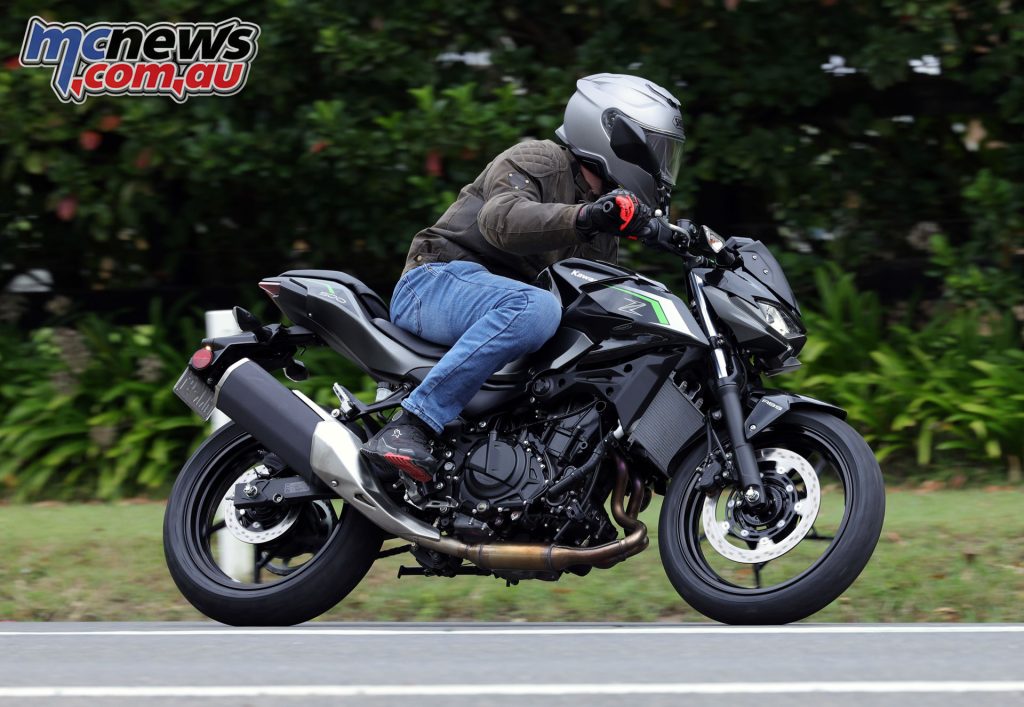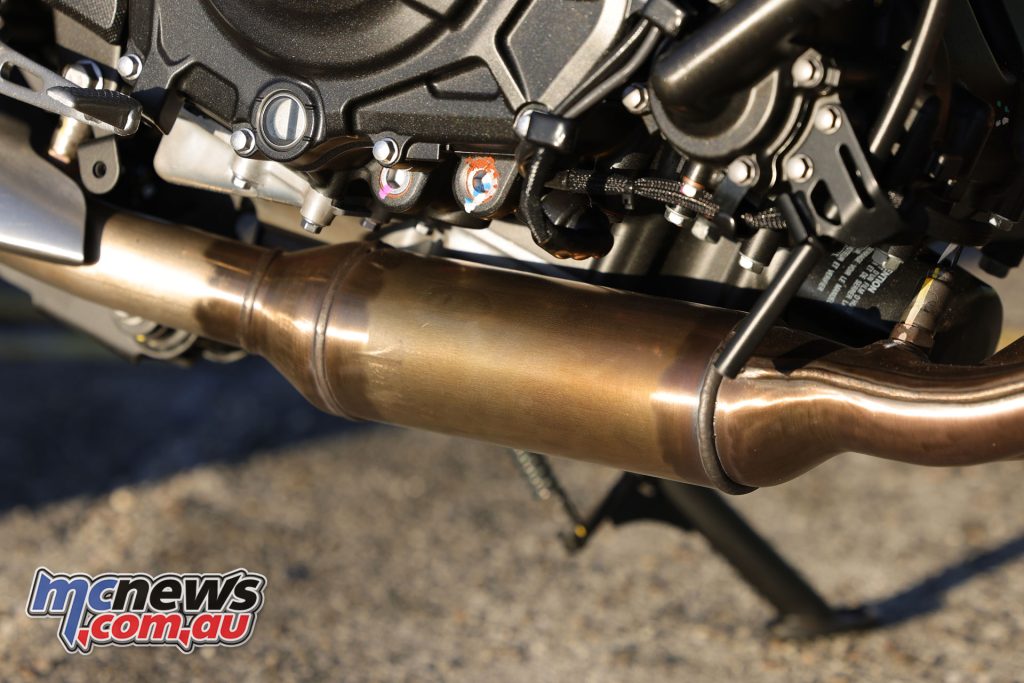2024 Kawasaki Z500 Review
Test by Kris Hodgson, Images Sam Kimber
This year is a big one for the 400-500 cc beginner class in motorcycling in many ways. Kawasaki has rolled out its larger 451cc parallel twin across the Z and Ninja lines, which are being called ‘500’s in Australia. This follows on from the new Eliminator cruiser, which runs the same engine.

I’ve been a fan of the Ninja 400 since 2018, so I was interested to see how the new Z500 stacked up. These Kawasakis are somewhat analogue by modern standards, but what tends to attract new riders is their reputation for reliability, dealer network support, and parts availability. And their performance is nothing to sneeze at—at least that’s what I’ve observed online chatting with new riders.

Updates on the new bike are a styling overhaul and smartphone connectivity (despite retaining an LCD dash), and the 451cc engine has had a pretty noticeable bump in torque, peaking lower in the rev range and losing peak power in doing so. Only the SE models run a TFT dash. Kawasaki is calling the bike a supernaked, but I think that’s a label best left to the 200+ hp nakedbikes.
We’re seeing peak torque at 42.6 Nm at 6000 rpm, up from 37 Nm at 8000 rpm previously, and power has dropped to 33.4 kW from 35 kW. If you’ve ridden the previous model, you’ll notice a meatier torque curve from right down low and carried across the entire rev range.

Torque on a road bike is more important than peak power, even more so on a smaller machine like this. That’s quite a positive difference, with great fuelling remaining a strong point. As on the previous 400s, the new bike doesn’t feel restricted or lacking ‘something’ either.
One of my few old gripes with the 400 is also addressed. The off-throttle transition to engine braking is now smoother, and doesn’t unsettle the bike as it sometimes did at ‘trundling around’ speeds. On the gas, this was never as much of an issue, but for commuting and suburban riding it really did peeve me.

There’s still a light clutch-action and that torque comes on smooth, so new riders should have a great time starting on one of the new 500s, as they did on the previous 400s. Learning to do U-turns or navigate through traffic will all be easy, with the bike not throwing any additional hurdles at beginners and remaining quite stall-resistant.
Gear changes are a little clunky in the lower gears and revs, which may just come down to the bike only having 500km on the clock. The shifts were quite smooth at speed.
With all that accessible torque, this is a rewarding mid-range machine, but apart from the new engine being quite loud mechanically, there are also some vibes, starting around 4500 rpm and most noticeable at around 6000 rpm.

In this part of the rev range, you get vibes through the ‘bars, and vision through the mirrors deteriorates, and I did end up avoiding 5000-6000rpm, either short-shifting or revving through to avoid sitting in that region. That meant riding in fifth gear on the highway at 110 km/h. Luckily the bike gets super smooth from 7000rpm onwards.
On the chassis side of things, Kawasaki doesn’t seem to have changed much. This wasn’t much of an issue in my mind, as the bikes were already good things, even if, on paper, the competition is running more impressive suspension and brakes. After all, it’s about the real world ride, and the Kawasaki 400s excel here. No frills, but very competent.

Handling remains neutral, responsive, and agile, with the bike weighing 167 kg fuelled, which is a real featherweight with 14L of fuel included. The Z500 goes where you look, holds a line effortlessly, and is also pretty forgiving. Ideal for a new rider, but still pleasing for those with more experience under their belt.
I’ve heard riders rubbish the Dunlop Sportmax GPR-300 tyres, but I’ve always felt they were an ideal option for beginner riders or commuters. These hoops perform well, wet or dry, and the wear is good too, which is an ideal mix, alongside a pretty good feel in all these conditions.

Despite just a dual-piston caliper on a single 310mm front rotor, brake performance is good, with a dual-piston caliper backing it up on the rear. If anything, the competition with its four-pot calipers seem to be running softer pads, bringing them closer to the Kawas in 2024, from what I’ve seen. The single front disc set-up here is more than up to the job, and it’s backed by ABS. There’s good modulation and feel, which is what you want for good control, and the bike is well-balanced if you do decide to trail brake into corners.
The suspension felt a little more taut despite having the same 41mm telescopic fork and pre-load adjustable shock I was used to on my Ninja. It was always quite compliant for me at 75 kg without getting too soft or feeling under-sprung. That front end still gives good feel and confidence, although it’s normally the rear I criticise.

That was the case here too, although only in a very specific situation. Doing a nice loop out of Sydney at more normal speeds of 80-100 km/h, the rear was good, but the occasional harsh bump was transferred through to me more than I’d like. It was fairly similar to what I remember on the 400 and really not too different to most of the new options being launched in 2024 in this 400-500 category.
Another loop up the Old Road during double demerits at a very legal 60-70 km/h was fairly punishing however, with the rear shock particularly harsh on the return trip. My spine really copped it here, and I was being pushed into the tank quite a bit, too. That was only a small portion of the riding I did, but it made an impact, if you’ll excuse the pun. Pre-load was sitting right on the middle setting for reference, but with all other riding being good, I avoided changing it.

The ergos of the Z500 are compact, with an accessible 785 mm seat-height, which is the same as the previous model. It had quite a tight seat to ‘peg ratio for my 32-inch inseam. It works, but I would not want longer legs. The reach to the ‘bars has plenty of bend at the elbows for me, keeping in mind at 180cm or so, I’m more leg than torso. It’s more noticeable as you tuck in for sportier rider and get a bit lower and more aggressive.
Thanks to the peg placement and tank contours, I was able to lock right into the tank easily and naturally, which was good. Overall, the bike felt quite comfortable. It was easy to move your weight around on it, too, which is appreciated, even if I was far from trying to get a knee down.

Now when the speeds rise and you’ve got a grin plastered from ear to ear, that rear shock does seem to sort itself out, while on more normal roads, like in the suburbs I never really noticed any problems. The seat, like the one on my old Ninja 400, gets uncomfortable quickly for my bony behind. Despite seeming to have quite a bit of foam padding to it I seemed to compact the foam a bit too easily.
On a more positive note, the bike looks significantly improved in the styling department, with a cleaner headlight, sportier radiator shrouds, and less bitsy bodywork. I do miss the green frame on the previous model, which really stood out, but a contrast-painted frame appears to be Z500 SE only for 2024.

Not running an enormous breadbox collector under the belly is also nice to see, and while the standard muffler isn’t that inspiring, it is also not an eye-sore in my opinion, while the mid-pipe section is minimal. A slip-on would really clean up the look of the muffler, and I’ve always favoured the Arrow options on the 400.
The headers are nicely contoured too, which draws the eye. That rear fender isn’t too bad either, for a stock item. There’s not a heap of exhaust note, but there’s a bit of intake growl that grows as the revs rise.

The LCD dash is a head-scratcher, mainly because the SE versions get a TFT, and there’s phone connectivity run through the Kawasaki app. Do you need phone connectivity on a bike with no TFT, no ride modes, and no electronics? I don’t think so, but I’m a bit of a Luddite in this area, and I can only assume this is an important inclusion according to Kawasaki’s research into their target riders.

On-road pricing of the new Z500 is $8,608 here in Sydney (the same as the 2023 Z400), with the SE another $900 at $9,535 ride-away. That does cover the additional TFT, USB-C outlet, smoked screen, belly-pan, pillion cowl, tank pad, knee pads, frame sliders and radiator screen.
Obviously, we’re still talking Kawasaki reliability, which is a big draw-card, even if this is technically a new engine. The previous 400s held their value very well, so I think there’ll be lots of appeal here, and there is the fact that the Z500 really looks the business.

Kawasaki has taken a fairly conservative approach to these model updates, but looking at the success of the Ninja 400 and Z400, it’s easy to see why. Most importantly, I had a heap of fun on the Z500, whether it was zipping through Sydney traffic or having a bit of a fang up The Old Road.

For more information on the Kawasaki Z500 head to the Kawasaki Motors Australia website (link), where you can chuck your postcode in for localised ride-away pricing.
| 2024 Kawasaki Z500 Specifications | |
| Engine | 4-stroke Parallel Twin |
| Displacement | 451 cc |
| Bore x Stroke | 70.0 x 58.6 mm |
| Compression Ratio | 11.3:1 |
| Valve System | DOHC, 8 valves |
| Fuel System | Fuel injection: ø32 mm x 2 |
| Maximum Power | 33.4 kW {45 PS} / 9,000 rpm |
| Maximum Torque | 42.6 Nm {4.3 kgfm} / 6,000 rpm |
| Cooling | Liquid-cooled |
| Lubrication | Forced lubrication, wet sump |
| Transmission | 6-speed, return |
| Primary Reduction Ratio | 2.029 (69/34) |
| Gear Ratio: 1st | 2.929 (41/14) |
| Gear Ratio: 2nd | 2.056 (37/18) |
| Gear Ratio: 3rd | 1.619 (34/21) |
| Gear Ratio: 4th | 1.333 (32/24) |
| Gear Ratio: 5th | 1.154 (30/26) |
| Gear Ratio: 6th | 1.037 (28/27) |
| Final Reduction Ratio | 3.071 (43/14) |
| Clutch | Slipper, wet multi-disc, manual |
| Final Drive | Chain |
| Frame | Trellis, high-tensile steel |
| Front Suspension | ø41 mm telescopic fork |
| Rear Suspension | Bottom-link Uni Trak, gas-charged shock with adjustable spring preload |
| Front Wheel Travel | 120 mm |
| Rear Wheel Travel | 130 mm |
| Rake | 24.3° |
| Trail | 92 mm |
| Steering Angle (L/R) | 35° / 35° |
| Front Tyre | 110/70R17M/C 54H |
| Rear Tyre | 150/60R17M/C 66H |
| Front Brake/s | Semi-floating ø310 mm disc |
| Front Caliper/s | Balanced actuation dual-piston |
| Rear Brake | ø220 mm disc |
| Rear Caliper | Dual-piston |
| Dimensions (LxWxH) | 1,995 x 800 x 1,055 mm |
| Wheelbase | 1,375 mm |
| Road Clearance | 145 mm |
| Seat Height | 785 mm |
| Curb Mass | 167 kg |
| Fuel Capacity | 14 litres |























































